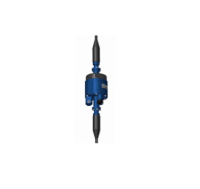In-line ZPulse Doppler Current Sensor 5800 / 5810 / 5800R / 5800RR / 5810E
The In-line Doppler Current Sensor (DCS) is the first current sensor with the option to directly connect water quality sensors in a robust, integrated package (version 5810). The sensor replaces the successful DCS4100 in-line current sensor using newer technology with extending capabilities. It is designed for easy integration into systems with Aanderaa or third-party dataloggers. Based on a modified version of the ZPulse Doppler Current Sensor 4520, it connects through a combined mooring and signal cable. For buoy application, when the buoy creates magnetic interferences with the internal sensor compass, it is possible to use an external compass solution.
Configuration
Available configuration settings include polled / non-polled mode, ping rate, recording interval, and settings for connected sensors for the 5810.
Working principle
The DCS sensor is based on the backscatter acoustic Doppler principle. It has two orthogonal transducer axes with two transducers on each axis. This enables the sensor to measure in both directions on each axis which is a great advantage. By utilizing only the two transducers that are facing upstream, the sensor is insensitive to disturbance from vortex speeds around the mooring and the sensor itself (forward ping functionality). One transducer on each axis transmits a short ultrasonic pulse simultaneously (one ping), the same transducers receive backscattered signals from particles in the water. This gives an orthogonal x and y speed component which is tilt-compensated to find the correct horizontal speed components.
The North and East speed components are calculated based on the x and y speed components and the heading from the built-in solid-state electronic compass. The sensor takes several of these two-component measurements and finally calculates the averaged north and east speed components and the vector averaged absolute speed and direction.
The two-frequency ZPulse technology provides higher precision data from each ping. This gain can be used either to obtain improved measurement precision or to reduce the average power consumption by halving the number of required pings.
The sensor can be configured using the provided Aanderaa Real-Time Collector software either directly connected to a computer or through SmartGuard or SeaGuard Datalogger. The Real-Time Collector is a powerful and efficient tool for data collection and control of Aanderaa’s oceanographic instruments and sensors.
Data logged by use of the SeaGuard Datalogger can be post-processed using SeaGuard Studio software, while data from SmartGuard can be view and exported by use of the Data Studio software. The Review software package is available for customized visualization of real-time data.
Features
Features
- Rugged and reliable sensor with high accuracy
- Build-in solid-state 3-axis tilt-compensated compass
- Heading and tilt-compensated for each ping
- Low power consumption
Applications
- Ocean / coastal observatories
- Harbour monitoring systems
- Data buoys
- Sensor strings
- Winch profiling systems
Specifications
Interfaces
- 5800 / 5810: AiCaP protocol
- 5800RR: RS-232 8)
- 5800R: RS-422
- 5810E: Engineering - Analog, AiCaP, RS-23 or RS-422
Power
- Supply voltage: 6-14VDC
Environmental
- Depth rating: 2000m
- Operating temperature: -5 to +40°C
- Dimensions: D: 129mm H: 369mm
- Materials and finish: Durotong, titanium
- Weight: 5,5 kg
Velocity measurement
- Current Speed: (Vector averaged)
- Range: 0–300cm/s
- Resolution: 0.1mm/s
- Mean Accuracy: ±0.15cm/s
- Relative: ± 1% of reading
- Statistic precision (std): 0.3cm/s (ZPulse mode), 0.45cm/s
Current Direction
- Range: 0–360° magnetic
- Resolution: 0.01°
- Accuracy: ±5° for 0-15° tilt; ±7.5° for 15-35° tilt
- Tilt Circuitry: Compass Circuitry:
- Range: 0-35°
- Resolution: 0.01° Resolution: 0.01°
- Accuracy: ±1.5° Accuracy: ±3°
Acoustics
- Frequency: 1.9 to 2.0MHz
- Power: 25 Watts in 1ms pulses
- Beam angle (main lobe): 2°
For version 5810 / 5810R: Optional sensors: Temperature Sensor 4060
- Range: -4-36°C (32-96.8°F)
- Resolution: 0.001°C (0.0018°F)
- Accuracy: ±0.03°C (0.054°F)
- Response Time 63%: < 2 seconds
Conductivity Sensor 4319
- Range: 0-7.5 S/m
- Resolution: 0.0002 S/m
- Accuracy 4319 A: ±0.005 S/m - 4319
- B: ±0.0018 S/m
- Response Time: < 3s
- Temperature
Range: -5–40°C (23-104˚F)
Resolution: 0.01°C (0.018°F)
Accuracy: ±0.1°C (0.18°F)
Response Time (63%): <10 sec
Wave and Tide Sensor 5217/5218 Tide:
- Several ranges available, wave max: 1000kPa (145psia)
- Resolution: <0,0001% FSO
- Accuracy: ±0.02% FSO, ±0.01%
- FSO on request
- Wave
Sampling rate: 2Hz, 4Hz,
No. of samples: 256, 512, 1024, 2048
Pressure Sensor 4117, several ranges available
- Resolution: <0.0001% FSO
- Accuracy: ±0.02% FSO, ±0.01%, FSO on request
- Temperature:
- Range: 0 – 36°C (32 – 96.8˚F)
- Resolution: <0.001°C (0.0018°F),
- Accuracy: ±0.1°C (0.18°F), Response Time (63%): <10 sec
Oxygen Optode 4835/4330
- Range: 0 – 500 µM (O2-Concentration), 0 - 150% (Air Saturation)
- Resolution: < 1 µM (O2-Concentration), 0.4 % (Air Saturation)
- Accuracy: <8 µ M or 5% (whichever is greater), <5% (Air Saturation)
- With multipoint calibration: <±2 µM or ±1.5%
- Temperature
Range: -5 to +40°C (23 - 104˚F),
Resolution: 0.01°C (0.018°F)
Accuracy: ±0.03°C (0.18°F),
Response Time (63%): <2sec
Reference: aanderaa.com
Another Article:
Pepperl+Fuchs GD18/GV18/73/120 Thru-beam sensor
Pepperl+Fuchs BB10-P-F1/25/33/35/103/115-7m Thru-beam sensor
Pepperl+Fuchs Thru-Beam Sensors
Bamo Pressure Switches KPI
Danfoss MBS 1900 Pressure Transmitter for Air and Water Applications


Komentar
Posting Komentar
Informasi Pilihan Identitas:
Google/Blogger : Khusus yang punya Account Blogger.
Lainnya : Jika tidak punya account blogger namun punya alamat Blog atau Website.
Anonim :